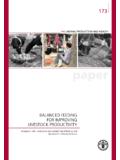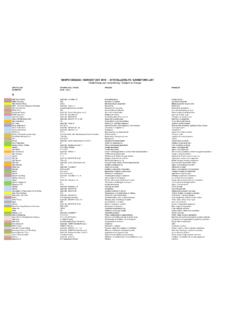Transcription of Schedule of rates - csst
1 Schedule of rates Classi cation units 2011. Notice The information contained in this brochure has no legal value. The of cial reference documents are the Act respecting industrial accidents and occupational diseases ( , chapter ) and the Regulation respecting the classi cation of employers, the statement of wages and the rates of assessment ( , c. , r. ), amended in 2010. (Gazette of cielle du Qu bec, September 29, 2010). The Schedule of rates contains only the titles of classi cation units. However, the Regulation details the activities covered by the classi cation units. For more information, consult the Regulation respecting the classi cation of employers, the statement of wages and the rates of assessment, published in the Gazette of cielle du Qu bec. Under certain conditions, an employer classi ed in a unit marked with an asterisk (*) may also be classi ed in an exceptional unit.
2 Commission de la sant et de la s curit du travail, 2010. Vice-pr sidence aux nances ISBN 978-2-550-59953-1 (version imprim e). ISBN 978-2-550-59954-8 (PDF). D p t l gal - Biblioth que et Archives nationales du Qu bec, 2010. D p t l gal - Biblioth que et Archives Canada, 2010. Table of contents Employers' classi cation 5. Premium rate 6. Joint sector-based associations 7. Premium rates per classi cation unit 9. Premium rates pertaining to the nancing of 21. joint sector-based associations for the year 2011. Employers' classi cation The classi cation of an employer in one or more units is based on the nature of all the activities carried on by the employer's enterprise. This method of classi cation speci cally allows to distinguish the activities of the enterprise from those that are contracted out, so that its classi cation accurately reflects the risks associated with its activities.
3 For example, consider a wholesaler in fruit and vegetables. If its employees are engaged in sales and administration, as well as transportation and warehousing, the employer will be classi ed in unit 54410, Wholesale trade in foodstuffs; wholesale trade in beverages, whether alcoholic or non-alcoholic; transporting of raw milk. Indeed, all its activities are related to wholesale trade in fruit and vegetables. However, if its employees are involved exclusively in sales and administration (transportation and warehousing being contracted out), the employer will be classi ed in unit 65110, Brokerage rm, professional services rm; rm offering administrative support services. On the other hand, an employer may be classi ed in more than one unit if it carries on activities that are of different nature. Thus, an employer operating both a restaurant and a pharmacy would be classi ed in two units.
4 Lastly, even if some of the employer's activities, considered in isolation, could be classi ed in separate units, they will not be so classified if they support one of the activities covered by another unit. Therefore, a manufacturer will not be classified in a unit related to the business of selling its own products to wholesalers or retailers. However, the activity of selling its products would be classified in a separate unit if the manufacturer operated a store located elsewhere than on its production site. 5. Premium rate To determine the premium rate corresponding to a particular unit, the rate- making process has two steps: establishing the average rate and calculating unit rates . The average rate takes into account the nancial requirements related to the administration of the occupational health and safety plan and all the insurable payrolls of employers registered with the CSST.
5 For 2011, the CSST evaluates the nancial requirements of the plan at approximately $ billion and estimates the insurable wages at $ billion. The aver- age premium rate for 2011 is $ for every $100 of payroll, the same as the rate for 2010. The general unit rate is determined by taking into consideration the cor- responding risk index for each unit. The index is obtained by comparing the experience data of a particular unit with that of all units. The unit rate is determined by multiplying the index by the average rate. However, the CSST sets different rates for enterprises whose activities come under federal jurisdiction. Their individual rates are lower because they are not subject to certain provisions of the Act respecting occupational health and safety. Therefore, those rates do not take into account the costs of prevention plans and the For a safe maternity experience program.
6 6. Joint sector-based associations Joint sector-based associations are bodies devoted to the prevention of employment injuries. They provide workers and employers in their respec- tive sectors with training and research services, information, advice and technical assistance in occupational health and safety matters. Speci cally, they can contribute to the training and running of health and safety com- mittees, design and provide training and information programs, and draft prevention guides and technical data sheets. With the exception of the construction sector where they are obligatory under the Act respecting occupational health and safety, they are created on a voluntary basis by employer and worker associations in the same activity sector. There are 11 joint sector-based associations that are run by joint boards of directors and nanced by a speci c assessment paid by the employers in the activity sectors for which such an association was formed.
7 A joint sector-based association rate is therefore added to the rate charged to these employers. For 2011, that rate varies from $ to $ for every $100 of insurable payroll. 7. Premium rates per classi cation unit Unit Unit title General Special number rate rate 10110 Breeding of cattle; operating a dairy cattle herd; breeding of horses; horse boarding or dressage service; operating a riding centre, a horse school or a racing stable; operating a farm animal auction site; breeding of domestic animals 10120 Breeding of pigs; breeding of sheep; breeding of goats 10130 Breeding of poultry; production of poultry or game bird eggs; operating a hatchery; poultry capture and caging service; candling and classi cation of eggs; breeding of rabbits; sh-farming; beekeeping 10140 Growing of cereal crops; growing of seeds or legumes; growing of forage crop plants; growing of fruit, vegetables or ne herbs in elds; growing of mushrooms; growing of sod; growing of tobacco.
8 Harvesting of peat 10150 Growing of fruit, vegetables or ne herbs in a greenhouse; growing of ornamental plants; growing of trees or shrubs;. operating an orchard; maple growing 11110 Deep-sea shing; mid-shore shing; coastal shing; fresh- water shing 13110 Operating a ferrous metal mine 13120 Operating a non-ferrous metal mine; operating a salt or diamond mine 13130 Operating an asbestos mine 13140 Operating a crushed or freestone quarry; operating a sandpit or a gravel pit; operating an industrial or structural mineral mine 13150 Core drilling for ore prospecting 13160 Sinking mine shafts; drilling declines, drilling mining roads or raising; drifting ore 14010* Forestry operations 14020* Forestry development 14030* Tree work 15010 Slaughtering of animals; meat cutting service; butchering of meat 9. Unit Unit title General Special number rate rate 15020 Manufacturing luncheon meats; meat, sh or seafood processing; manufacturing ready-made dishes 15030 Manufacturing food for animals; mixing or processing of grains 15040 Manufacturing beverages, whether alcoholic or non- alcoholic; manufacturing fruit or vegetable juice 15050 Preparation of fruit or vegetables; manufacturing munchies 15060 Manufacturing pastry products; manufacturing bakery products; manufacturing flour; manufacturing confection- ery products 15070 Processing of coffee; processing of tea, spices, seasonings or ne herbs; manufacturing herbal teas; roasting of nuts, almonds or legumes 15080 Processing of milk; manufacturing dairy products 16010 Manufacturing rubber tires.
9 Vulcanizing rubber tires 16020 Manufacturing rubber products 16030 Manufacturing plastic bags 16040 Manufacturing plastic products 16050 Manufacturing reinforced plastic products 16060 Manufacturing ammunition; manufacturing explosives 16070 Manufacturing body hygiene and care products; manufac- turing drugs 16080 Manufacturing cleaning or maintenance products; manu- facturing adhesives; manufacturing ink; manufacturing coating products; manufacturing fertilizers 16090 Manufacturing synthetic resins; re ning of crude oil; manu- facturing petrochemical products; manufacturing chemical products 17010 Manufacturing threads; manufacturing woven fabrics; manufacturing carpet made of textile materials 17020 Manufacturing knitted fabrics; manufacturing tapes, elastic bands, lace, rope, laces or belt-webbing 17030 Manufacturing clothing of the cut and sewn type; manufac- turing knitted clothing 17040 Manufacturing or repairing articles made of canvas; manu- facturing decoration and furniture accessories made of textile materials 10.
10 Unit Unit title General Special number rate rate 17050 Manufacturing footwear; manufacturing luggage or leather- craft made of textile materials, leather or imitation leather;. manufacturing gloves, belts, suspenders or neckties made of textile materials, leather or imitation leather; operating a shoe repair store 17060 Finishing of threads, fabrics or clothing; coating of fabrics 18010 Manufacturing doors and windows, in wood or plastic 18020 Manufacturing solid wood panels; manufacturing wood floors; manufacturing wood mouldings; manufacturing wood furniture components; manufacturing wood stairway components; manufacturing wood cabinet doors 18030* Manufacturing in the plant or the workshop of wood frame buildings; manufacturing in the plant or the workshop of mobile homes or worksite trailers having a wood frame, manufacturing in the plant or the workshop of wood frame house panels 18040 Manufacturing wood cof ns; manufacturing or restoring musical instruments having a wood structure.





